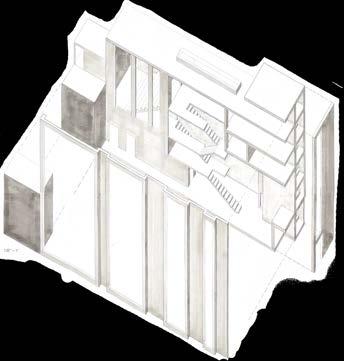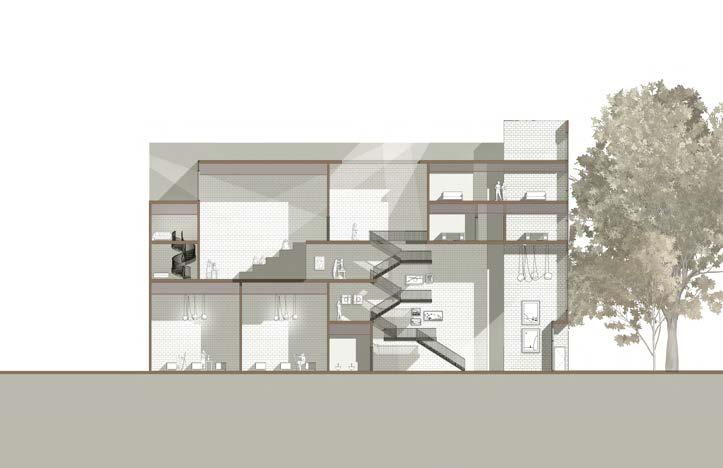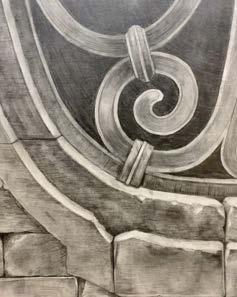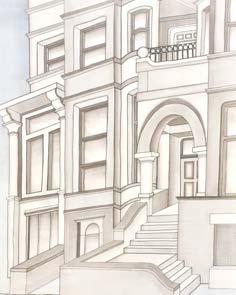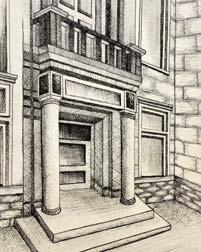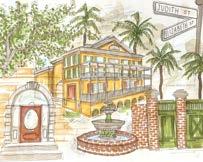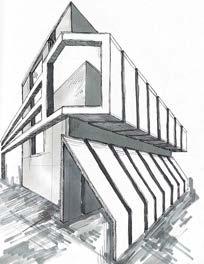laurin uptegrove architecture portfolio




laurin uptegrove architecture portfolio



phone (937) 974-9683
email laurin.uptegrove@gmail.com
address 244 Thomas Green Blvd. Clemson, SC 29631
Master’s of Architecture + Health
Clemson University, Clemson, South Carolina, May 2025
B.S. Business Administration
Concentration in Accounting at Winthrop University, Rock Hill, South Carolina, May 2022
Springboro High School Dayton, Ohio, May 2018
Clemson Materials Lab Gradute
Assistant
August 2022 — Present
Assist faculty and students with various tasks in the laser cutting, 3D printing and woodshop labs.
Gresham Smith Architectural Intern Charlotte, North Carolina
May, 2024 — August 2024
Worked on construction drawings, completed record drawings, went on several site visits and helped with interior renderings.
Graduate Architecture Professional Partnership (GAPP) VP of Finance
Division I Student-Athlete Winthrop Women’s Soccer, Captain
Winthrop Honors College
Beta Alpha Psi International Honor Society, Member
Google and Microsoft Office Suites
Photoshop, Illustrator, InDesign
Revit
Rhino
AutoCAD
Bluebeam
Lumion and Enscape
Laser cutting and 3D printing
Hand drafting
Student Athlete Advocacy Committee (SAAC) President
August 2021 — May 2022
Representated Winthrop Athletics at Leadership Conferences, promoted civic engagement opportunities to students, educated athletes on their NIL rights, and lead diversity, equity and inclusion campaigns.
First-Year Experience Peer Mentor
August 2020 — May 2022
Assisted a Winthrop University faculty member in preparing and acclimating freshman students to their first semester of college. Johnson, Laschober & Associates
Architectural Intern Augusta, Georgia
May 2023 — August 2023
Prepared architectural drawings for deadlines, took field measurements, created as-built models in Revit, worked independently on residential projects and presented plans to clients.
Nucor Skyline Steel, LLC Accounting Intern
Rock Hill, South Carolina
May 2021 — August 2021
Assisted with month-end close tasks, created a historical data analysis, conducted a companywide internal audit, and presented the findings at an intern summit in Indianapolis, Indiana.
TRiO and Student-Athlete Tutor
August 2020 — May 2022
Supported students in their studies and guide them through various business, accounting, biology, mathematics, computer science, and writing courses.
Rock Hill High Girls’ Varsity Soccer
Assistant Coach
January 2021 — May 2022
Assisted the head coach in practice preparation, game strategies, and supervision of kids.
Research Assistant
Heatlh Equity + Enviornmental Design Lab
Obtained a CITI certification in Social and Behavioral Research to conduct a POE at Cincinnati Children’s
Programming and Pre-Design
Site analysis, site planning, and design charrette facilitation for an Alternative Labor + Delivery Center with Post-Natal Retreat
Miracle Park Buddy
Assist children with disabilities in a Saturday morning tee-ball league


THE RESERVE: A Restorative Watershed
COMMONING: Exchange, Gather, Meander
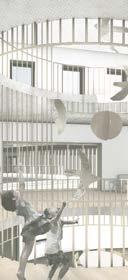
VOZNESENS’K SCHOOL OF INCLUSION: A Home for the Neurodiverse

THE FOOTFILLS TEXTILE SCHOOL: Asheville, North Carolina
05 06 07

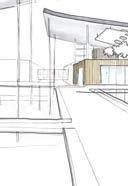
THE STUDENT’S
CENTER:
Bridging Commute and Comfort
STOREFRONT FOR PHILOSOPHY: The Montessori Method for Adults

PERSONAL WORK: Studio Art
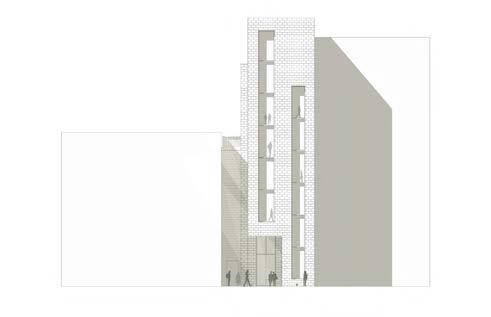
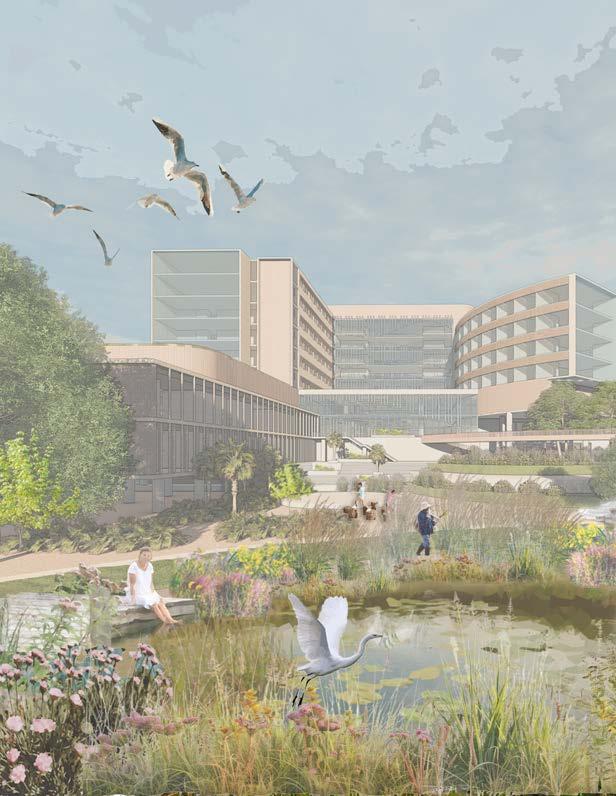

— Charleston, SC
The proposed campus plan is a resilient, sustainable design that tackles rising sea levels, stormwater management, and equitable green space access. The hospital incorporates strategies for energy efficiency, water conservation, material selection, and ecosystem preservation, with a focus on supporting marsh migration to safeguard Charleston’s coastal environment. Reflecting the city’s strong connection to water, the design enhances the healing experience for patients, staff, and visitors, offering both aesthetic value and psychological comfort to alleviate the stresses common in healthcare settings.
Year Fall 2024, A+H Studio
Professors David Allison + Dr. Lyndsey Deaton
Partner
Jennifer Johnson


In the initial site analysis, we found that the medical campus in Charleston lacked a sense of scale compared to the city, with large buildings that lost the human scale. The district also has low tree coverage, minimal green space, and lies in a vulnerable area prone to frequent flooding. By 2100, constant floodwaters are projected to surround the site.




The hospital design creates an indoor-outdoor experience, particularly in the atrium, to providing a restorative environment for patients, staff, and visitors. Large windows and glazed curtain walls maximize natural light and views of water and green spaces. Native plants, stone, and other natural materials blur the boundary between indoors and outdoors, enhancing tranquility. Interior water features further emphasize the connection to nature, providing calming sounds and reinforcing the water theme.





EXPLODED AXON
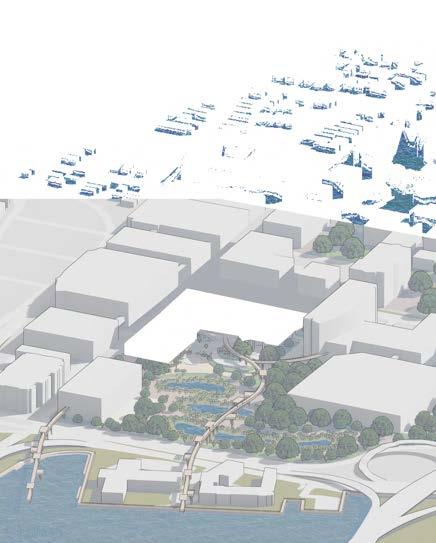




The building integrates water into its design at both urban and hospital scales. The hospital collects rainwater for non-potable uses, such as toilet flushing, and incorporates green roofs and swales to slow runoff. The site stores stormwater in the watershed park and retention ponds across the medical campus, reducing peak runoff and mitigating flood risks while promoting sustainable water management. The native plants incorporated into this system not only thrive in Charleston’s coastal environment but also improve water filtration, reduce erosion, and support flood resilience.
LIVING MACHINE SECTION


PUBLIC ATRIUM SECTION PERSPECTIVE

The hospital design integrates highefficiency HVAC systems and passive design strategies like daylighting and solar shading to achieve a 25% reduction in energy use compared to conventional hospitals. Continuous performance monitoring will ensure that these energy-saving measures, alongside the use of renewable energy and highefficiency systems, meet sustainability and operational goals throughout the building’s life.


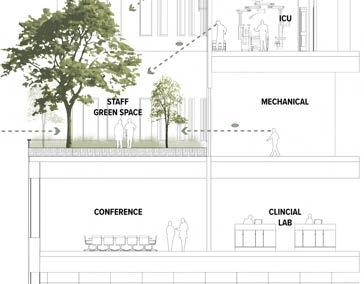
The hospital’s design integrates waterfront views and access to the adjacent stormwater park, which enhances well-being by providing calming, restorative environments for patients, staff, and visitors. By incorporating water and nature into the healing experience, the hospital reduces stress, improves mood, and promotes faster recovery, while also reflecting Charleston’s cultural connection to its waterways and addressing climate resilience through stormwater management.
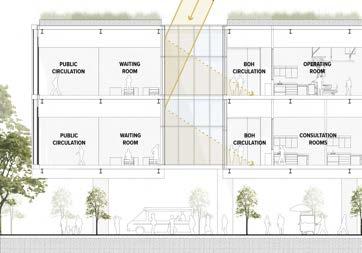
LEVEL 2


LEVEL 3 ICU LEVELS 4-7 MED/SURG LEVELS 4-9

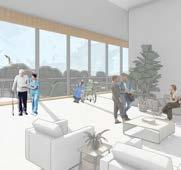


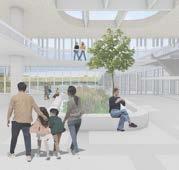


Indian Land, South Carolina
A sustainable, 100-bed hospital on a naturally terraced, 85-acre site
Year Fall 2023, A+H Studio
Professors David Allison + Dr. Lyndsey Deaton
Partners Luke Chung + Maithili Awasarikar
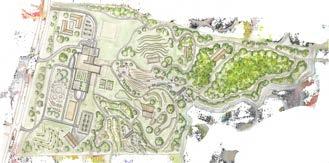
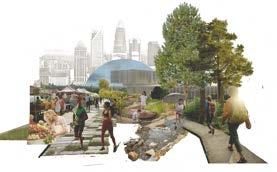
INDIAN LAND, SC is a rapidly growing exurban community with endangered ecosystems and limited access to natural resources, healthy food, and greenspace.
The Catawba Indian Nation and cotton farmers of the area viewed movement along trade routes as a way to enrich their culture and overall wellbeing. Wellness is an active process toward a successful existence.
EXCHANGE







HOPSITAL COMMONS

Historically, commons are uncultivated fields near a town or village that allow the commoners to establish equal access to cultural and natural resources like air, water, and habitable earth. Commons form generative communities that lays its focus on producing fresh, organic goods that have an equal and ongoing social and environmental impact for both producers and consumers.

Fresh air and rainwater is used to ventilate and cool the inpatient tower. A dedicated outdoor air system consists of chilled water piping and an energy recovery wheel.

DESIGN FOR ENERGY
ELECTRIC HOSPITAL
Resilient and sustainable power supplies reduce dependency on finite fossil fuels and mitigate the impact of energy-related disruptions, thus safeguarding critical medical services and patient care.





















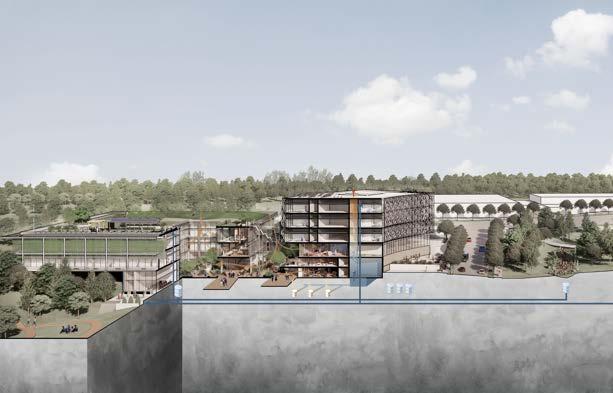



BIORETENTION
3,046,254 GAL/YR IS FILTERED THROUGH LAYERS OF MULCH, SOIL, GRAVEL, AND A PERFORATED PIPE



Voznesens’k, Ukraine
The Voznesens’k School of Inclusion is a residential boarding school in Voznesens’k, Ukraine, designed for K-8 children with cognitive and developmental disabilities. This safe, nest-like facility serves as a sanctuary for internally displaced children, aiming to restore and transform a community affected by collective trauma. The school focuses on reconciliation and addressing the systemic causes of the challenges faced by these children.



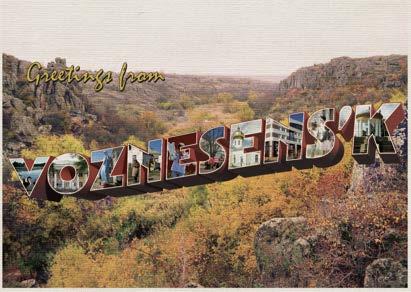



This project involved an intensive research phase during which we created several physical models to explore spatial concepts for our buildings. One model, featuring a crane and a mobile, symbolizes the interconnectedness of internally displaced people, reflecting their enduring desire to rebuild and reconnect with their country. The second exploration was a postcard that unfolded into a pop-up house. During our frequent meetings with the city council of Voznesens’k, we discovered that postcards play a key role in their efforts to promote tourism, as they hope to inspire visitors to come and explore the city.
TYPICAL STREET TYPOLOGY
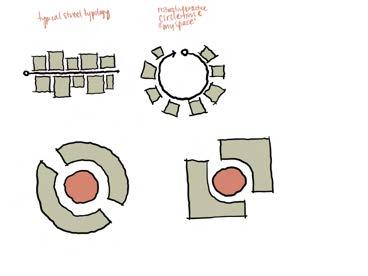
BLOCKS COMBINE PROGRAM + SEPARATE BLOCKS

EMBRACE COURTYARD + RESPOND TO SURROUNDING SITE
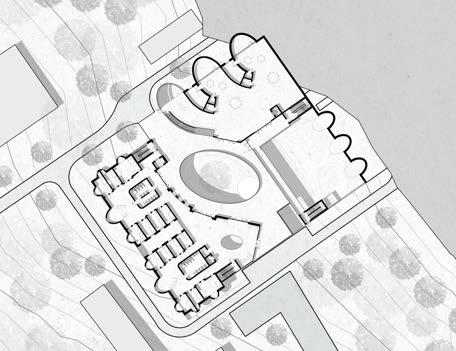


Young people with disabilities need support to become independent and fully integrated into society, and targeted support can help that transition. A nest supports...
Recognizing the diverse needs of neurodivergent children underscores the importance of fostering inclusivity. These principles are woven into the fabric of our facility to enrich the residents’ human experience, fostering autonomy, socialization, and personalized care access.
The facility comprises a residential block and an education block surrounding a central courtyard. A ground-level platform shields the central playground on the bunker level, offering a sheltered yet airy and naturally lit play area. This platform also serves as a pathway for children to travel between their residences and the school on a circular track, mirroring the experience of navigating a typical neighborhood and aiding in the development of their cognitive mapping skills.


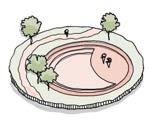
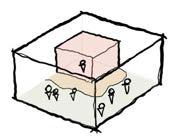
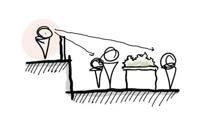




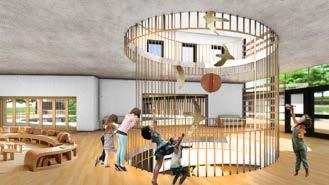
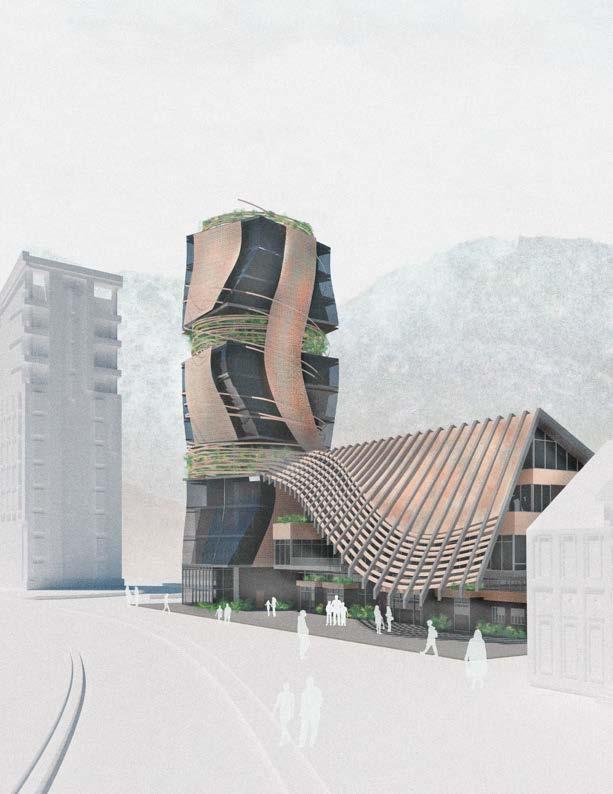

Asheville, North Carolina
A proposed satalite campus with housing for NC State’s Wilson College of Textiles.
Year Spring 2023, M.Arch I Studio
Professors
Dr. Peter Laurence + Brandon Pass























The Foothills Textile School is designed to resemble the textile process from start to finish with an emphasis on the history of the textile industry in the Southeast. Students at this campus would primarily focus their studies on a textile fabrication technique that was used before the Industrial Revolution. The spiral of the residential tower and the woven facade of the school suggests the weaving movement of individuals coming together to practice the artistry of textile production. The threads of this project are the residents, copper, and landscape that intertwine to create a community-based learning environment.
Each student of the Foothills Textile School is required to teach a class to the public focusing on any textile activity of their choosing. The goal is to educate the public on the safety, health, and ecological issues of today’s textile industry, with hopes to inspire the public to shop local and seek sustainable textile options. The textiles produced by the students can be sold at the on-site market open to the public or donated to the homeless shelter in Asheville. Lastly, as the public strolls through the market, there are monuments on display to commemorate textile employees and enslaved individuals who were forced to work in the industry before the Industrial revolution.






















































Level 2 (Tower Repeats on 8 + 12) Residences + Classrooms














































Level 3 (Tower Repeats on 7+11) Residences + Event Space





















































Level 4 (Tower Repeats on 6 +12) Residences



























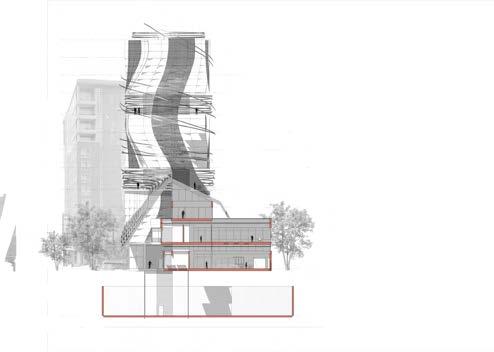




Clemson, South Carolina
A student center focused on mental health, wellness of the psyche, and a calm sense of being-in-the-world.
Year Fall 2022, M.Arch I Studio
Professors
Dr. Ufuk Ersoy + Dr. Peter Laurence
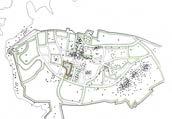
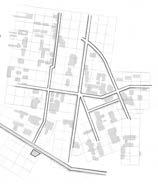
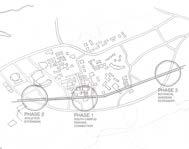
Interface incorporates a walking bridge from Clemson’s most populated commuter lots to improve one’s daily commute by improving accessibility and leading students through a peaceful student center upon arrival and departure.
The student center serves as a gateway to campus, channelling thousands of students through a public commons with adjacent private meditative spaces as well as public dining and excercise spaces. The walkway is a versitaile pedestrain route that provides safe access to campus but also surrounding greenspaces in the Clemson community to increase physical and mental wellbeing.

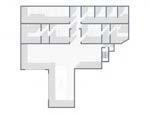
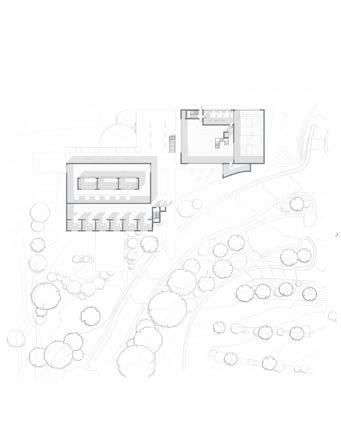

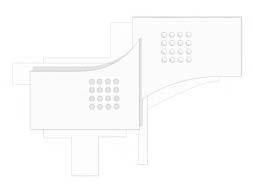


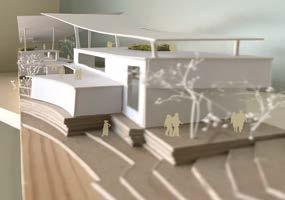






South Carolina
An application of Plato’s theory of enlightenment through an urban infill.
Year Fall 2022, M.Arch I Studio
Professors
Dr. Ufuk Ersoy + Dr. Peter Laurence




The client, Maria Montessori, wanted a transcendental space where daylight and shadow were the primary elements and where intellectual, spatial, atmospheric, and material investigations of Plato’s Allegory of the Cave are present. Maria, an educational pioneer of the mid 20th century, believed that children learn best in a natural, holisitic environment when given the independence to explore their own interests. Ms. Montessori believed that this approach to early childhood education could also benefit young adults as they pursue higher education. The adult montessori school provides the students with natural light, inspiration, and freedom to explore the arts.



Montessori education consists of four levels of developmental independence; physical, intellectual, social, and moral. Maria Montessori envisions a space that promotes self-reflection and encourages artists to express themselves. The central staircase acts as a tiered gallery space and is representative of the instrinsic motivation necessary to achieve enlightment. The vertical lightwells are designed to provided plentiful natural daylight for a warm and inviting learning environment.
